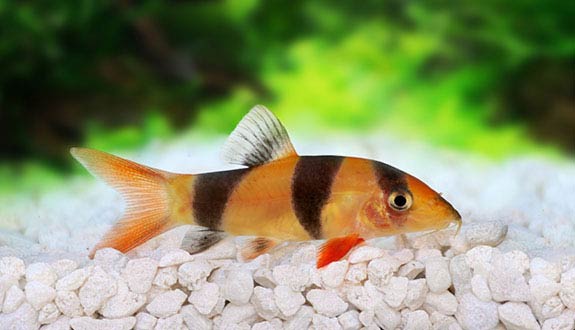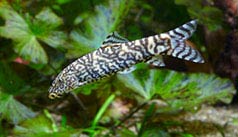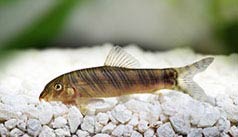

Alternative species (click on the thumbnail to see the card)
Names
Scientific name
Chromobotia macracanthus
Botia macracanthus
Common name
Clown loach
Tiger botia
Origin

Origin: Indonesia, Malaysia
Biotope: Asian
Dimorphism

Not very apparent. The male is stockier and has a higher back
Group

Cobitidae
Volume

600 L / 132 imp gal / 158 US gal
Parameters

T°: 26 to 28°C or 79 to 82°F
pH: 6.5 to 7
Hardness: 1 to 8°dGH
Difficulty

Average
Size

20 to 35cm (8 to 14")
Longevity

15 to 20 years
Living zone

Middle and depth
Individuals

6
Food
How to feed the Clown loach?
Food
How to feed the Clown loach?
Omnivorous, the Clown loach willingly accepts all forms of food. It remains mostly carnivorous, with a clear preference for live prey (snail, mudworms, etc...).
Behavior
What kind of behavior does the Clown loach have?
Behavior
What kind of behavior does the Clown loach have?
Gregarians, the Clown loach must imperatively live in groups of 5/6 individuals minimum (10 ideally). This group will form a very complex social hierarchy. Normally, it is the largest female that has dominance on the shoal. If the group is too small, the fish can become aggressive between them. Indeed, the dominant individual can become so stressful that in some cases the dominated stop eating. Likewise, an isolated loach will become aggressive towards the species that resembles it.
In general, it’s a dynamic, lively, always moving, playful and even funny species (it sometimes swims sideways or upside down)! You will often see them settle in unexpected positions, wedged vertically or horizontally between the elements of the scenery, or completely lying on the ground. Do not worry, in most cases, these are natural resting positions.
Tendency to be active rather at night.
Cohabitation
Who can live with the Clown loach?
Cohabitation
Who can live with the Clown loach?
Of a peaceful nature, the loach accepts community aquariums under certain conditions.
In fact, do not associate them with other groundfish such as Corydoras (which could starve in the face of this 30 cm (12 inch) wolverine!). Also avoid fish that are too small or too quiet that might be frightened by its intense activity. The loaches can also «pinch» large-finned species such as Guppy, Betta or many cichlids.
You can maintain it with Crossocheilus, barbs Pentazona, Garra, Epalzeorhynchos or the genera Balantiocheilos, Barilius, Barbonymus, Luciosoma for example.
Breeding
How to breed the Clown loach?
Breeding
How to breed the Clown loach?
Extremely difficult (only possible using hormones). The rituals of natural breeding are very complex and difficult to imitate in captivity.
Its aquarium
Which aquarium for the Clown loach?
Its aquarium
Which aquarium for the Clown loach?
Since the Clown loach is a groundfish, a substrate of non-cutting fine sand is imperative. Plan also many hiding places. You can do this by using roots, rocks (this fish likes raised positions!). Watch out for the stability and security of your decoration: the Clown loach likes to sneak into cracks, crevices and interstices. We must therefore ensure that the decoration is not sharp (use worn rocks for example) and that no hiding place is too small (the fish can then get stuck in). Complete your arrangement with very sturdy and secure plants, as the loach uproots and eats the most tender plants.
The Clown loach does not like bright lights and often looks for shady areas. Therefore, favor soft lighting or sift your aquarium with floating plants.
Finally, equip your aquarium with a good filtration, which ensures a good oxygenation of the water, will eliminate the organic waste and will offer a strong current much appreciated by the Clown loach. Be careful however to offer areas with lower current to allow the fish to rest.
Good To know
Find all additional information!
Good To know
Find all additional information!
This loach often eats snails. This peculiarity has become a selling point, but you will have understood, as for its need of congeners, as for its size and longevity, the purchase of a Clown loach should not be taken lightly!
In volumes too small, the Clown loach becomes dwarfed, becomes sensitive to diseases and its longevity is very seriously undermined: absolutely avoid this!
Particularly susceptible to the white spot disease and pharmaceuticals. Also note that the Clown loach does not like dirty water, so it will be necessary to provide a weekly water change of 30 to 50%.
Sometimes this fish emits an audible snap. The behavioral aspects of this phenomenon remain unexplained.
Note that this species loses its colour and becomes almost gray in adulthood.
Yours photos!
Comments
Sort by:
Please login to post comments



